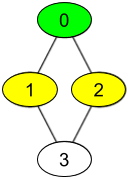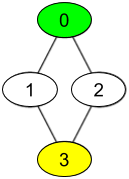- {x}
- Find the Team Size
- Find N Unique Integers Sum up to Zero
- All Elements in Two Binary Search Trees
- Jump Game III
- Verbal Arithmetic Puzzle
- Running Total for Different Genders
- Decrypt String from Alphabet to Integer Mapping
- XOR Queries of a Subarray
- Get Watched Videos by Your Friends
- Minimum Insertion Steps to Make a String Palindrome
- Decompress Run-Length Encoded List
- Matrix Block Sum
- Sum of Nodes with Even-Valued Grandparent
- Distinct Echo Substrings
- Convert Integer to the Sum of Two No-Zero Integers
- Minimum Flips to Make a OR b Equal to c
- Number of Operations to Make Network Connected
- Read More...

Get Watched Videos by Your Friends
There are n people, each person has a unique id between 0 and n-1. Given the arrays watchedVideos and friends, where watchedVideos[i] and friends[i] contain the list of watched videos and the list of friends respectively for the person with id = i.
Level 1 of videos are all watched videos by your friends, level 2 of videos are all watched videos by the friends of your friends and so on. In general, the level k of videos are all watched videos by people with the shortest path exactly equal to k with you. Given your id and the level of videos, return the list of videos ordered by their frequencies (increasing). For videos with the same frequency order them alphabetically from least to greatest.
Example 1:

Input: watchedVideos = [["A","B"],["C"],["B","C"],["D"]], friends = [[1,2],[0,3],[0,3],[1,2]], id = 0, level = 1 Output: ["B","C"] Explanation: You have id = 0 (green color in the figure) and your friends are (yellow color in the figure): Person with id = 1 -> watchedVideos = ["C"] Person with id = 2 -> watchedVideos = ["B","C"] The frequencies of watchedVideos by your friends are: B -> 1 C -> 2
Example 2:

Input: watchedVideos = [["A","B"],["C"],["B","C"],["D"]], friends = [[1,2],[0,3],[0,3],[1,2]], id = 0, level = 2 Output: ["D"] Explanation: You have id = 0 (green color in the figure) and the only friend of your friends is the person with id = 3 (yellow color in the figure).
Constraints:
n == watchedVideos.length == friends.length2 <= n <= 1001 <= watchedVideos[i].length <= 1001 <= watchedVideos[i][j].length <= 80 <= friends[i].length < n0 <= friends[i][j] < n0 <= id < n1 <= level < n- if
friends[i]containsj, thenfriends[j]containsi
Solution Explanation: 1311. Get Watched Videos by Your Friends
This problem requires finding the videos watched by friends at a specific level of distance from a given person. The most efficient approach is using Breadth-First Search (BFS).
Algorithm:
-
Initialization:
- Create a queue
qto store the IDs of people to visit, starting with the givenid. - Create a
visarray (or set) to track visited people, initially marking the startingidas visited. - Create a
cntdictionary (or hash map) to store video frequencies.
- Create a queue
-
BFS Traversal:
- Iterate
leveltimes. In each iteration:- Process all people currently in
q. For each person:- Iterate through their friends (
friends[i]). - If a friend is not yet visited (
!vis[j]):- Mark the friend as visited (
vis[j] = true). - Add the friend's ID to
q.
- Mark the friend as visited (
- Iterate through their friends (
- Process all people currently in
- After
leveliterations,qcontains the IDs of all friends at the specified distance.
- Iterate
-
Video Frequency Counting:
- Iterate through the IDs in
q. For each IDi:- Iterate through the videos watched by that person (
watchedVideos[i]). - Increment the count of each video in the
cntdictionary.
- Iterate through the videos watched by that person (
- Iterate through the IDs in
-
Sorting and Returning:
- Convert the
cntdictionary's keys (videos) into a list. - Sort the list of videos based on their frequencies (ascending). If two videos have the same frequency, sort them alphabetically (ascending).
- Return the sorted list of videos.
- Convert the
Time Complexity:
- BFS traversal visits each person at most once, so it takes O(n) time, where n is the number of people.
- Counting video frequencies takes O(v) time in the worst case, where v is the total number of videos watched by friends at the specified level.
- Sorting the videos takes O(v log v) time.
- Therefore, the overall time complexity is O(n + v + v log v), which simplifies to O(n + v log v).
Space Complexity:
- The queue
qstores at most n IDs. - The
visarray takes O(n) space. - The
cntdictionary stores at most v entries. - Therefore, the overall space complexity is O(n + v).
Code Examples:
The code examples provided earlier in different languages (Python, Java, C++, Go, TypeScript) all implement this algorithm. They differ slightly in syntax and data structures used but share the same core logic. The efficiency of each implementation is consistent with the complexity analysis.